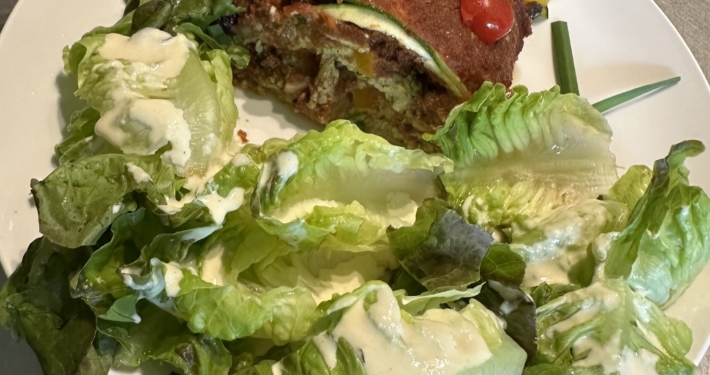Kitchen Culture: The Science and Art of Fermentation
Fermented foods have many benefits. They are heavy metal chelators, they heal the gut and have a dramatic influence on mental emotional disorders. A variety should be included in a daily detox diet. Depending on the bio-individual needs of the patient, cultured raw foods and beverages provide benefits like improving sleep, digestive functioning & elimination, increasing energy & immune system efficiency, clearing acne, and reducing sugar cravings, dramatically. People all over the world have been creating cultured products for thousands of years. Not only are they delicious, but they have been used as a home remedy for allergies, bronchial asthma, anemia, chemical sensitivities, diabetes, gout, longevity, rheumatism as well as supplemental treatment for cancer patients.
Benefits: The Science
Fermentation occurs in foods when certain yeast and/or bacterial cells metabolize carbohydrates in an oxygen free environment. This conversion of sugars into organic acids – or alcohols and carbon dioxides – creates foods that have little demand on the pancreas and are good for diabetics. Optimizing gut health, from stomach to intestines, is perhaps the most powerful benefit of cultured foods.
To understand the importance of gut health, consider that eighty percent or more of the immune system is located in the gut and that there are ten times more bacterial cells than human cells in the human body. Fermented foods optimize the beneficial bacteria while crowding out pathogenic bacteria and are therefore profoundly important for disease prevention. This natural antibiotic effect from bacteriocin is far better for your system than antibiotics from the pharmaceutical industry, which are indiscriminate to the good, bad, and neutral bacteria.
The culturing of foods creates many beneficial byproducts, one of the most dominant being lactic acid. Lactic acid aids in digestion by stimulating the secretion function of all digestive organs and strengthening the acidity of the stomach when hydrochloric production lags, a common problem for adults over age 30. Whilst preserving nutrients, lactic acid breaks food down, making it more bioavailable. The enzymatic quality aids in digestion, in the same way that enzymes from your salivary glands are designed to do… when food is chewed slowly and thoroughly. Another result of fermentation, Acetyl-choline, assists in the circulation of the blood, and stimulates the peristaltic movement of the intestines – thus promoting bowel movements. It also has a pronounced calming effect on the nervous system, which can improve mood and sleep patterns. Choline, a type of B vitamin, assists in fat metabolism, lowers cholesterol, and lowers blood pressure.
The aforementioned health benefits hold true for fermented vegetables, fruits, and sweet teas, but there remains some controversy on the subject of Rejuvelac (a beverage made from fermented soft wheat grains). Made popular by Ann Wigmore’s Living Foods Lifestyle in the late 60′s, it has been regarded as a delicious enzyme and friendly flora packed drink that contains all the vitamin Bs as well as vitamins K, E, C and water soluble minerals. In her book “Hippocrates Live Food Program” Dr. Ann Wigmore quotes food chemist Harvey Lisle, who did extensive research on Rejuvelac’s contents in the 1980′s, “Rejuvelac is rich in proteins, carbohydrates, dextrines, phosphates, saccharins, lactobacilli and Aspergillus oryzae. Amylases are enzymes derived from Aspergillus oryzae which have the faculty of breaking down large molecules of glucose, starch and glycogens.” Over a decade later, Dr. Brian Clement, Co-Director of Hippocrates Health Institute, was quoted in a lecture: “We paid for a study on Rejuvelac; we naively thought the fermentation would always be good bacteria. The study found that this was not the case; 40% of the batches tested were good, 60% were bad.” There are conflicting opinions about relying on smell to determine if the bacteria are good or bad, as there are conflicting opinions between those that swear by the health benefits of the beverage and those that caution against it’s potential danger.
Variety: The Spice of Healthy Life!
In our convenience-centric society, one could easily be tempted to reach for a probiotic pill to change the ecology of the gut. However, fermented raw foods and beverages are exponentially more potent than even the strongest probiotic pills; and while probiotic pills may be taken with fermented products, they are not sufficient as a stand alone source of balancing the body’s levels of pathogenic bacteria.
Furthermore, incorporating a variety of fermented foods provides different profiles of bacteria, species and strains to keep the immune system healthy. For example, yogurt culture is abundant in Lactobacillus bulgaricus, but doesn’t have beneficial yeast. Alternatively, kefir is a symbiotic relationship between beneficial yeast and Saccharomyces boulardii bacteria. Coconut kefir is also rich in minerals, electrolytes and probiotics. Likewise loaded with probiotics & B vitamins, kombucha also contains a substance called glucuronic acid which binds up environmental and metabolic toxins so that they can be excreted through the kidneys. Another cultured beverage, beet kvass, has liver cleansing properties, promotes cell respiration and stimulates the immune system.
Let’s not forget the mother of all fermented vegetables, cabbage. The synthesis of protein, carbohydrates and fats takes place in cabbage leaves, they contain everything essential for our metabolism and are rich in nutrients and lactic acid bacteria. It is no wonder that cabbage has been noted as “the physician of the poor” since the 1800′s.
Ancient Wisdom: Get Cultured!
Many people in our culture have a fear of aging food outside of refrigeration because they are raised to view bacteria as dangerous, even deadly. If you recall the earlier mention that bacterial cells in the human body out-number human cells ten to one, this fear may seem oxymoronic.
Safely fermenting foods is far from rocket science; it’s been recorded as early as 200 BC, when Chinese cooks began pickling cabbage as a condiment. Stories suggest that it was first created by accident; ever since, fermentation has been crucial is South East Asia because food spoils rapidly in the warm moist climate. Conversely, in the pre-industrial age, the only way to have access to vegetables in harsh winter conditions was to ferment them. Fermented products were consumed by Ancient Egyptians, Grecians, and Romans as well. It is because fermented cabbage keeps so well, that Genghis Khan toted it during the Eastern Invasion of Europe. That is when Germans adopted the tradition, thusly coining the term ‘sauerkraut’ (sour cabbage). Kombucha, also dating back to China over 2000 years ago, is consumed under various names throughout Europe & Asia, and has made it’s way to the United States.
The healing properties of cultured goods have been utilized for ages. Emperor Tiberius actually carried several barrels of sauerkraut as protection against intestinal infections. In the eighteenth century, when sailors often suffered from scurvy (vitamin C deficiency), Captain Cook sailed with it and didn’t loose a single sailor to the epidemic in his three year voyage. During the cholera epidemic, Russian soldiers drank kvass because it protects against infectious disease and was therefore safer than sharing a glass of water. Today still, South Americans often give munkoyo, a lacto-fermented brew made from millet or sorghum, to babies to protect them against infection and diarrhea.
In today’s processed american diet, there remains a semblance of this tradition… though, it is often diluted to tasty condiments – a pickle with deli sandwich, a peperoncini with pizza, etc. Our not-so-cultured culture seems to have lost value in the nutritional and healing properties of fermented products. Instead, more and more people seek gut relief from drug stores.
Integrating Good Taste
Part of reclaiming your health includes habitual ingestion of fermented products. Because they push bacteria out through your stool and pores, the idea of consistent replenishment is important; eating heaps in one sitting will not do the trick. When adding cultured foods and beverages into your diet, it is advised to start small as not to overwhelm the detox pathways of the body with the alloys, BPAs and heavy metals that fermented products free from body storage. Indicators that detoxification is working may first be experienced as diarrhea, flatulence, or skin breakouts- do not stop if this happens, but slow down to your body’s tolerance. For example, a very toxic liver may be too sensitive to the detoxification products that the kombucha helps release. In such cases, begin the first few weeks of the detox process using beet kvass, which helps the liver cleanse itself, until kombucha can be tolerated.
Ultimately, it is advised to work your way up to a quarter to half a cup, with two meals a day and a third serving of another type of culture. An example of optimum incorporation may look like: 1/2 cup of yogurt with breakfast, 1/2 cup of fermented vegetables (or occasionally fermented fruit) with lunch, and a glass of kombucha or kvass with an afternoon snack or before dinner.
Unless you have a raw, organic, unpasteurized source, it is difficult to rely on purchasing products that may seem cultured. For example, many store bought yogurts are made with pasteurized milk, full of dead organisms and then typically are loaded with sugar. Packaged sauerkraut is usually heated and pasteurized, and therefore has lost most vitamin C and enzymes. So, to promote optimum health and vitality, it’s time to develop cultured taste in your kitchen!
The Art of Fermenting Vegetables and Fruits
Preparing fermented recipes is a fun and simple process. Once you understand how it works, you can get really creative with your favorite flavors!
Containers
There are a variety of container options, no matter which you choose, it’s imperative that it’s squeaky clean. Wide mouth mason jars are the simplest and least expensive choice. You could also use a Harsch crock, which are specifically designed for kraut. They come with stone weights and can be left alone for weeks, requiring only that the little moat under the lid be refilled with water. Some complain that the Harsch crocks are expensive, heavy, and tend to produce a cheesier flavor because, depending on the environment, they can make too much yeast. Whatever you decide, definitely avoid plastic jars, as harmful substances can be absorbed into preserved foods.
Ingredients
Choosing organic is important, it improves nutritional value and often heavily fertilized cabbage can rot before it begins to culture. If for some reason, some pesticide do wind up on your foods, the good news is that the fermentation process breaks down those types of chemicals. Therefore, inorganic produce will be far less toxic when fermented.
In the plant kingdom, species growing closer to the soil have more lactic acid bacteria, which acts as an inoculant and a preservative, making them choice vegetables if you want to ferment naturally (without a starter). Typically, seventy five percent of a mixed fermented vegetable recipe should be comprised of shredded green cabbage, stalk included. Cabbage essentially induces natural wild fermentation, a two to four week process – climate pending. You may speed up the process by adding an inoculant, like few tablespoons of whey (clear yellow liquid that’s on top of yogurt), a commercial starter, fermented juice, Rejuvelac, etc. If you opt to use a commercial starter, take note that there are two types of lactic acid bacteria: one that is adapted to plants and one that is adapted to dairy products.
It is advised to add a variety of vegetables to your cabbage base in order to culture different nutrients and probiotic strains. Suggested raw veggies to ferment include: all types of cabbage, beets, cauliflower, celery, celery root, cucumbers, leaks, onions, peppers, rutabagas, tomatoes, and turnips. The only vegetables to avoid preserving raw are green beans because they contain a toxic substance called phasin, which interferes with digestion. Phasin decomposes when heated, so green beans must be cooked before preservation.
The following herbs and spices may be added to infuse minerals, enhance flavor, and help prevent decay: bay leaves, caraway seeds, uncut coriander, dill, garlic, horseradish, juniper berries, red pepper, tarragon, mustard seeds, and hints of pimento and clove. Feel free to add fruit like apples or pears and get creative with your favorite combinations of vegetables, fruits, and herbs!
Preparation
Once you’ve cleaned your raw produce of dirt, toss all shredded and/or chopped ingredients in a bowl. Hard veggies, such as red cabbage, should always be pounded and crushed until soft and juicy. You may choose to add sea salt, which acts as a temporary preservative via crowding out pathogenic bacteria so the beneficial probiotic bacteria can take over. If you are going to use salt, add one teaspoon of sea salt per one pound of cabbage; do not use iodized table salt. If you don’t want to use salt, juice organic celery as it has naturally occurring sodium that does the same thing.
The next step is to pack your mixed veggies and/or fruits, with optional preservatives and optional starter, into your chosen container. Use a potato masher or ladle if you don’t have a kraut pounder to pack the ingredients in tight. You want to keep the culturing food anaerobic, oxygen-free, by pushing all bits under the liquid. If you do not have enough brine from pounding the veggies, you may add salt water, cabbage juice, or celery juice. Once it’s packed in, take a cabbage leaf about the size of the mouth of the jar, push it down over the mix until the liquid comes over the top of it, and tuck it against the edges of the jar to form a seal (similarly, if you are using a Harsch crock, leave an inch of brine covering the weight stones). This helps prevent mold from growing by preventing oxygen from getting to the top of the vegetables.
When twisting on the lid of the mason jar, don’t tighten it too much, just until it naturally stops turning. This way the carbon dioxide can escape as it builds up. Place the jars in a dark place, preferably atop a pan or dish to catch any juice that might bubble or hiss out of the jar as the organisms are breathing. Veggies like to culture anywhere between 68 and 75 degrees and must stay below 80 degrees, as heat destroys microbes and takes away from the beneficial, nutritional quality of the food. You don’t have to be so rigid as to use a thermometer… it’s okay to smell/taste check it when you think it might be ready!
Once it’s fermented, keep your goodies refrigerated to prevent the bacteria from continuing to grow. Each time you remove a serving, use a clean utensil to push the cultured food back down under the liquid. This will help keep fermented veggies from getting mushy or fruit from getting alcoholic over time.
As you can see, the creative options for fermenting foods are endless. If you are just beginning, here are a few simple starter recipes for inspiration…
Fermented Vegetable Recipes
Sauerkraut
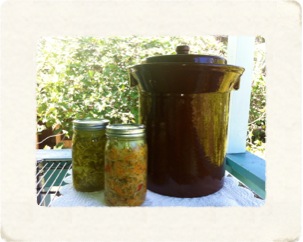 Savory: shredded green cabbage, chunks of red onion, leeks, kale, dill, parsley, chopped garlic, with a bit of tomato in a brine of cabbage & celery juice and spiced with caraway seeds & chili powder.
Savory: shredded green cabbage, chunks of red onion, leeks, kale, dill, parsley, chopped garlic, with a bit of tomato in a brine of cabbage & celery juice and spiced with caraway seeds & chili powder.
Sweet: shredded green cabbage, shredded red cabbage, chunks of beet, cilantro, red bell pepper, chopped ginger, with a bit of granny smith apple in a brine of carrot & celery juice and spiced with curry powder.
Kim Chee
(Korean version of sauerkraut) Shredded Napa cabbage, green cabbage, chunks of white onion, bok choy, sliced carrot, chopped daikon, ginger, and garlic in a brine of cabbage & celery juice and spiced with chili powder & cayenne.
Cucumbers
- Select medium sized hard cucumbers.
- Either slice or poke holes in them to allow fluid exchange.
- Season with chopped horseradish root to keep the pickles crisp, some tarragon, ground coriander, chopped onion, garlic, and a bay leaf.
- Fill the jar with water and add your salt or starter, make sure the cucumbers are completely submerged in liquid and seal.
- After 7-14 days at room temperature, refrigerate for another two to three weeks before serving.
Fermented Fruit Recipes
The preparation of fermented fruit is the same as detailed above for vegetables. However, with fruit, you are more likely to need salt as a preservative until the cultures take hold. A teaspoon of sea salt per pound is all you need.
Salsa
- Mix chopped: tomatoes (seeds removed and set aside), papaya, onion, pineapple and/or mango, mint and/or cilantro…
- With pureed: tomato seeds, lime juice, a pepper (jalapeño, habanero or chili) & few cloves garlic.
- When the fermentation process is complete, you may add chunks of avocado and a dash of olive oil.
Green Papaya Salad
- Mix a base of grated: papaya & carrot…
- With chopped: cilantro, green onion & basil, minced: lemongrass & thai chili and sliced cherry tomatoes.
- Season in chili powder and pound heavily in lemon juice.
Fermented Beverage Recipes
Kombucha
In order to make kombucha tea, you must first obtain a SCOBY (Symbiotic Culture/Colony Of Bacteria and Yeast), also known as a “kombucha mushroom”. In fermented tea a SCOBY ‘mushroom’ converts the sugar and tea into beneficial substances. Also, make sure to use organic tea, commercial tea is high in fluoride, which is toxic.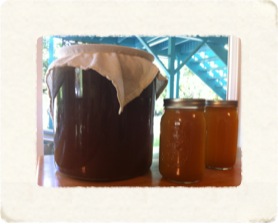
- Boil 4 cups of water to steep 6 tsp of organic green tea (for at least 10 minutes).
- Strain the tea and dissolve 1 cup of organic brown sugar in the warm water.
- Then add 9 cups of room temperature filtered water (for a total of 13 cups of water).
- Pour into a gallon glass jar with wide mouth, don’t use plastic or metal.
- Add one cup of finished plain kombucha and the SCOBY.
- Cover the jar with cheesecloth, secure with a rubber band, and let it sit in a warm, shaded place for 1-2 weeks, climate pending. Taste to determine if it is ready to drink, it should be sweet and sour.
- Remove the SCOBY with clean hands. Each time you make kombucha, you grow another SCOBY, so carefully separate them. Set the new SCOBY aside in a bit of finished kombucha or apple cider vinegar.
- Harvest the liquid and pour in quarter jars, leaving 1/2 inch of breathing space, and let them sit in room temperature and continue to ferment for another 2 days to a week. It would be wise to place a pan under the jars to catch drips as carbonation builds.
- Then chill it in the refrigerator and it’s ready to drink. Kombucha lasts in the fridge for up to three months. Once a bottle is open, it is recommended to drink it within a week.
- Using the new SCOBY and an ounce of finished kombucha, start another batch immediately.
Beet Kvass
Kvass a lacto-fermented beverage made from stale rye bread, currants, raspberries, lemons, apples, pears, cherries, bilberries or lingonberries. The Russians use it in soup (Borscht), and you can add it to salad dressings or drink it as a beverage.
- Wash and chop 3 large beets (or 5-6 smaller beets). Do not grate, as they will exude too much juice and ferment too quickly, resulting in alcohol not lactic acid.
- Place into a 2 quart mason jar with a tablespoon of sea salt and fill the container with filtered water, stir and cover.
- Allow it to sit at room temperature for 3-5 days then transfer to the refrigerator.
- When most of the liquid has been drunk, you may fill up the container with water and repeat the fermentation process, reserving some of the liquid to use as your inoculation for the next batch. The resulting brew will be slightly less strong than the first. After the second brew, discard the beets and start again.
Noni Juice
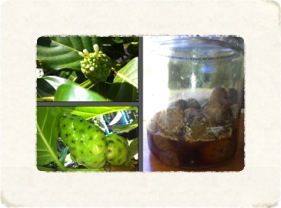 Harvest ripe noni from the tree: a noni is ripe when it is yellow all around, often there is a green residual area at the top end of the fruit. As the fruit ripens the green disappears and is replaced by a bright yellow color all around, then it becomes white translucent and the fruit falls off. Do not pick fruit from the ground as they may be contaminated by insects.
Harvest ripe noni from the tree: a noni is ripe when it is yellow all around, often there is a green residual area at the top end of the fruit. As the fruit ripens the green disappears and is replaced by a bright yellow color all around, then it becomes white translucent and the fruit falls off. Do not pick fruit from the ground as they may be contaminated by insects.- Wash the fruits and dry them. Place them in a sealed container filled all the way to the top and leave in a warm shaded place for a couple of weeks, climate pending.
- As the fruit ripens in the container, a yellow fluid will exude from them. Collect this juice and place in the fridge.
- Enjoy 2 oz of this nourishing beverage in the morning.
Rejuvelac
- Rejuvelac can be used as an inoculant or as a beverage itself. If you choose to use Rejuvelac, despite the previously mentioned concerns, you could test the pH to be safe; it should be acidic with a pH less than 3.9. A slight acidulation of the water with a little lemon juice at the start of the fermentation may provide an environment less suited to pathogenic organisms.
- Soak 2 cups of soft wheat berries in purified water for 8 hours, covered with clean cloth napkin.
- Drain, rinse, then allow to sprout for 2 days, away from direct sunlight, only rinsing if the grains look like they are getting dried out.
- When white sprout tails begin to show, grind the wheat in your blender with water. It’s not necessary to puree it completely, just chop them up a bit to give more surface area to ferment.
- Then, add 6 cups of purified water, cover the jar with cheesecloth, and allow it to ferment in at least 70 degree temperature for 24 to 36 hours.
- Rejuvelac should smell tart when finished. It has a slight lemony flavor. If it smells bad or tastes bad, it went past the good fermentation stage and should be discarded.
- Strain out the seeds and refrigerate the Rejuvelac. The seeds can be used one more time, with 4 cups of purified water and will culture in one day. Then seeds can be composted, or thrown to the birds.
- If drinking Rejuvelac as a beverage, you can flavor it with lemon or mint.
Yogurt and Kefir Recipes
This is the vegan option, using coconut instead of dairy for culturing products like kefir and yogurt.
Kefir
- Use organic young coconut water, the sweeter the coconut, the better it will ferment. Ideally use un-pasteurized coconut water with fresh coconut or from the frozen section at your health food store. If it is pasteurized or not very sweet, add one teaspoon of sugar to one liter of coconut water.
- Add one packet of Kefir starter per liter, make sure it is a water starter and not a dairy starter as the microflora are different.
- Bottle in a loosely twisted mason jar, place in a pan to catch drips, and let sit in a warm dark place for 10-48 hours, depending on climate.
- Refrigerate and enjoy! You can add juice of lemon, lime, ginger tea and/or stevia to taste.
Kefir Yogurt
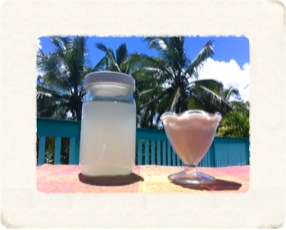 Take young coconut meat, clean the brown parts off, and puree it with a little coconut water. The puree should equal about a quart.
Take young coconut meat, clean the brown parts off, and puree it with a little coconut water. The puree should equal about a quart.- You can inoculate with starter powder or fermented coconut water. Be sure to slowly stir the probiotic in after it is blended, not in the blender as the heat will kill the culture.
- The yogurt will ferment in 8-12 hours.
- Refrigerate before serving. You can sprinkle a little fruit on top and enjoy with breakfast or as a dessert!


